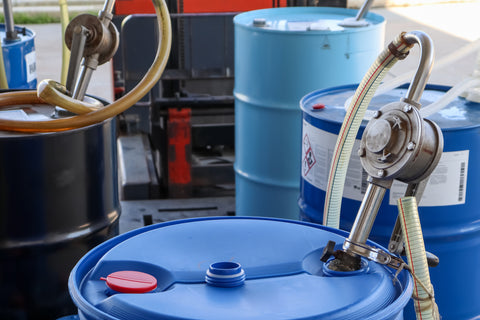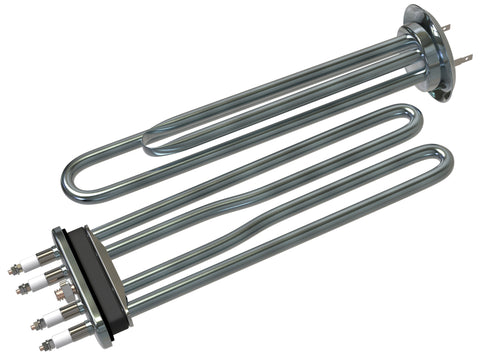Keeping Your Outdoor Dog Cozy: Why Insulation Matters
Keeping your dogs warm during winter is essential for their comfort and well-being. With a wide variety of doghouse options available, premade or DIY, there are steps you can take to ensure that winter doesn't risk the health and safety of your pets. If you go down the DIY route and plan to use a plastic barrel dog house, you may wonder how to best insulate it to maintain warmth and protect your pet from the cold. In this guide, we'll provide practical tips and step-by-step instructions on how to insulate a barrel dog house using various materials and tools, such as drum heaters and insulation. We’ll also address common questions about maintaining an insulated dog house and discuss the benefits of process heating products for optimal warmth.
Why Insulate a Barrel Dog House?
Insulating a barrel dog house is crucial to keeping your pet warm during cold months. Unlike regular dog houses, which often come with built-in insulation or thicker materials, a barrel dog house made from plastic barrels can lose heat quickly. Insulating it helps to retain your dog’s body heat, making the house warmer and more comfortable.
An insulated dog house reduces the risk of hypothermia, frostbite, and discomfort that dogs can experience in cold weather. Proper insulation keeps the interior temperature more stable, allowing the house to maintain a warm environment even on the coldest days.

Materials You’ll Need to Insulate a Barrel Dog House
To effectively insulate a barrel dog house, gather the following materials:
-
Bubble wrap: Provides an extra layer of insulation inside the house.
-
Fiberglass insulation: A great material for maintaining warmth.
-
Cedar chips or straw: Natural bedding materials that help to retain heat and provide comfort.
-
Plywood: To create a raised floor and reinforce the roof and walls.
-
Heating Elements: Products such as a blanket or barrel heater, heat trace, or other pet-specific options are ideal for providing consistent warmth, especially in extremely cold climates.
-
Weatherstripping and caulk: To seal gaps and prevent cold air from entering.
These materials will help create a comfortable environment that maintains your dog's body heat and protects against the cold.
Step-by-Step Guide: How to Insulate a Dog House
Step 1: Choose the Right Location
Start by placing the dog house in a sheltered location, ideally near a wall or under a canopy. This positioning acts as a natural windbreak, reducing exposure to harsh winds. The house should be elevated off the cold ground to prevent moisture buildup, which can make it colder inside.
Step 2: Insulate the Barrel Walls
Cover the interior walls of the barrel dog house with bubble wrap to provide a barrier against the cold air. Apply one sheet of fiberglass insulation over the wrap for added warmth. Secure the insulation properly to prevent it from shifting or being chewed by your dog. The combination of wrap and insulation will help trap heat inside the house, keeping it warm even on the coldest days.
Step 3: Add Floor Insulation
To insulate the floor, use a piece of plywood to create a raised base, which helps keep the dog house's interior dry and warm. For additional insulation and comfort, you can lay cedar chips or straw on the floor. For even more insulation, consider using a heated base mat. The Barrel Warmer Base Heater provides consistent warmth at the floor level, ensuring your dog remains comfortable even in freezing temperatures.
Step 4: Seal Openings and Gaps
Use weatherstripping or caulk to seal any gaps around the door or in the walls of the barrel dog house. Sealing these gaps prevents cold air and moisture from entering while still allowing for proper ventilation to ensure your pet stays safe and comfortable. If your dog house has a door flap, check it regularly for wear and replace it as needed.
Step 5: Use Heating Options for Additional Warmth
For regions prone to extreme cold, adding a heating element to your dog house can offer extra protection from the harsh temperatures. Options such as drum heaters, heated pads, or base heaters can provide consistent warmth without creating dangerous hot spots. When combined with proper insulation materials like foam or fiberglass, these heating solutions can help ensure your dog stays comfortable and safe even in the coldest conditions.
Using a Drum Heater to Keep Your Dog House Warm
In regions with particularly cold climates, a heater that can wrap around your doghouse or be installed along the walls or floor, can provide the extra warmth your dog house needs to stay comfortable. Designed to wrap around the exterior of a plastic barrel, these heaters offer a gentle and consistent heat source without creating hot spots that could harm your dog. When combined with other insulation materials like bubble wrap or fiberglass, a drum heater can be highly effective in maintaining a stable temperature inside the house.
Drum heaters are especially helpful in cases where traditional insulation alone isn’t enough to keep the dog house warm during extreme winter conditions. They are energy-efficient, easy to install, and safe when used properly around pets.
Tips for Installing a Heater Wrap for a Barrel Doghouse
-
Wrap the heater around the outside of the barrel, ensuring it fits snugly.
-
Secure it with the provided straps or clamps.
-
Plug it in and set the desired temperature to maintain consistent warmth.
-
Regularly inspect the heater for any signs of wear or damage to ensure it continues operating safely.
By incorporating a drum heater into your insulated dog house setup, you can create a warm and cozy environment for your pet, even during the coldest winter days.
How Cold is Too Cold for Dogs Sleeping Outside
Breeds That Struggle in Cold Weather vs. Cold-Resistant Breeds

Not all dogs have the same ability to tolerate cold temperatures, and understanding your dog's breed can help you determine how much insulation is necessary. Breeds with short hair, such as Greyhounds, Chihuahuas, and Boxers, often struggle in the cold due to their lack of natural protection. These dogs need extra insulation and heating in their outdoor dog houses, as they lose body heat quickly.
On the other hand, cold-resistant breeds like Huskies, Malamutes, and Saint Bernards are better equipped to handle lower temperatures due to their thick fur coats and natural ability to retain heat. While these dogs may still benefit from insulated dog houses, they generally require less additional heating compared to short-haired or smaller breeds.
How to Insulate a Wooden Dog House? | How to Winterize a Plastic Dog House?
To insulate a wooden or plastic doghouse, line the walls and roof with foam board or fiberglass insulation and cover it with plywood for added protection. Seal any gaps with caulk and ensure the house is raised off the ground to prevent cold air from creeping in. Adding bedding like straw or wood chips creates extra warmth during winter, while door flaps can help block out wind and retain heat. For a plastic barrel doghouse, this approach works well in both winter and summer, as insulation not only keeps the cold out but also prevents overheating. Consider using a small heater in winter to maintain consistent warmth or removing the insulation during hotter months to ensure better airflow.
How Can I Make My Dog House Warmer? | What Can You Put in a Dog House to Keep It Warm?
If you live in a climate in which insulated dog houses are not needed all year round, there are many options available to help you get your pups through a colder winter. Several materials, such as straw, cedar chips, or other wood chips, blankets, and thermal mats, can keep a dog house warm. For extra warmth, insulate the walls and floor with bubble wrap or foam board, seal gaps with caulk, and raise the house off the cold ground. Installing a drum heater or heated base mat can also help maintain a consistent temperature, especially in winter, ensuring your dog stays comfortable.
Tips for Maintaining an Insulated Dog House Throughout Winter
-
Regularly check the insulation for wear and tear, especially if using materials like straw or cedar chips.
-
Replace any damaged insulation to ensure the dog house remains warm.
-
Monitor the temperature inside the house and adjust heating products or upgraded materials as needed.

Conclusion: Keep Your Pet Comfortable Year-Round
Insulating your dog's house is essential for maintaining your pet's comfort and health throughout the winter. Adding insulation using a combination of materials and utilizing various heating products to maintain temperature control ensures a warm, safe environment. Regular maintenance and monitoring will keep your dog's living space cozy, no matter the weather. For an overall improved experience for your pets, consider using bucket heaters to ensure that their water stays at a drinkable temperature in even the coldest of weather.
Investing in the right insulation products and techniques will make your dog's outdoor experience more comfortable and safe, providing peace of mind for you as a pet owner.







